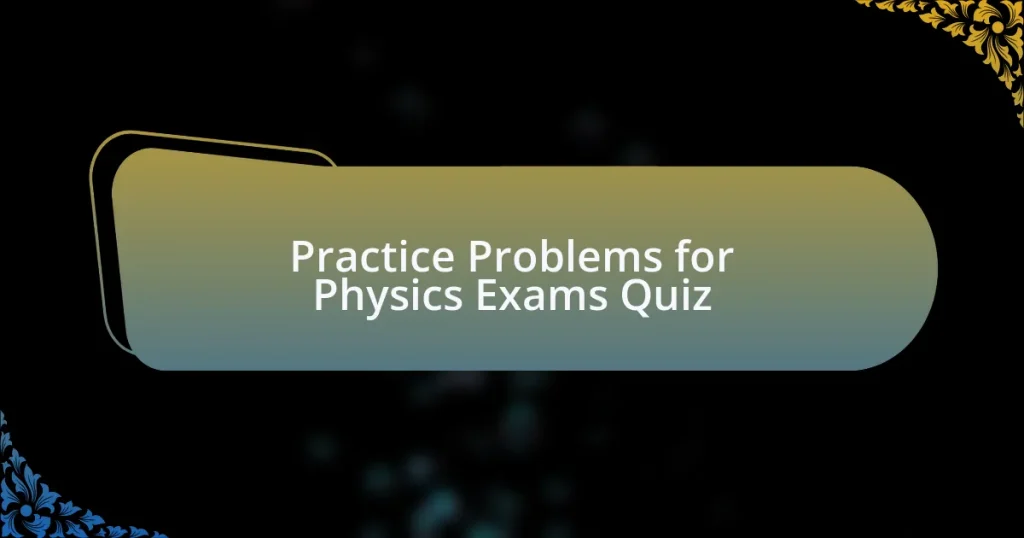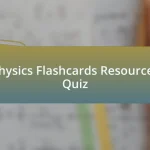Start of Practice Problems for Physics Exams Quiz
1. What is the initial speed of the green ball if it hits the ground at the same time as the red ball, which travels at 40 m/s at an angle θ = 20°?
- 35.0 m/s
- 10.6 m/s
- 15.0 m/s
- 25.3 m/s
2. If the red ball travels a distance dr before hitting the ground and the green ball travels a distance dg, how does dr compare to dg?
- dr = dg
- dr > dg
- dr < dg
- dr >> dg
3. What is the value of μk, the coefficient of kinetic friction between a block and a ramp if the block covers 50 cm in 1.7 s?
- μk = 0.743
- μk = 1.000
- μk = 0.520
- μk = 0.365
4. How would μk change if the mass of the block were doubled?
- μk would decrease
- μk would stay the same
- μk would become zero
- μk would increase
5. How would μk change if the time it takes the block to slide the distance d were increased?
- μk would fluctuate
- μk would stay the same
- μk would decrease
- μk would increase
6. What is Δxmin, the minimum amount the spring must be stretched to keep a block at rest on a rough ramp?
- Δxmin = 0.027 m
- Δxmin = 0.075 m
- Δxmin = 0.120 m
- Δxmin = 0.053 m
7. How would Δxmin change if μs decreased?
- Δxmin would stay the same
- Δxmin would decrease
- Δxmin would double
- Δxmin would increase
8. What is the unit of capacitance in the SI system?
- Farad
- Volt
- Ohm
- Joule
9. A Newton is equal to which of the following?
- gram-square meter per second squared
- kilogram-meter per minute squared
- kilogram-meter per second squared
- joule per meter
10. For an object moving in uniform circular motion, what is the direction of the instantaneous acceleration vector?
- directed horizontally to the right
- directed tangentially outwards
- directed radially inward
- directed vertically upwards
11. What is the work done on a 10 kg block lifted 2 meters?
- 150 Joules
- 200 Joules
- 300 Joules
- 100 Joules
12. To convert a galvanometer to a voltmeter, what should be added?
- a coil in parallel
- low resistance in parallel
- high resistance in series
- a capacitor in series
13. The greatest induced EMF will occur in a straight wire moving at constant speed through a uniform magnetic field when the angle between the wire`s motion and the magnetic field is?
- 0 degrees
- 180 degrees
- 45 degrees
- 90 degrees
14. What is the velocity of the ball relative to the elevator shaft the instant the boy releases it?
- 10 meters per second up
- 15 meters per second down
- 20 meters per second down
- 5 meters per second sideways
15. Which series describes electron transitions to the N=1 orbit in a hydrogen atom?
- Balmer series
- Paschen series
- Lyman series
- Brackett series
16. Electric current may be expressed in which unit?
- volts
- coulombs/second
- ohms
- joules
17. A 10 kg mass rests on a horizontal frictionless surface. A horizontal force of 5 Newtons is applied. After 1 second, what is the velocity of the mass?
- 3 meters per second
- 10 meters per second
- 0.5 meters per second
- 0.2 meters per second
18. A worker lifts a 10 kg block a vertical height of 2 meters. What is the work done on the block?
- 150 Joules
- 250 Joules
- 100 Joules
- 200 Joules
19. What is the orbital radius of moon Alpha if moon Beta orbits planet X with speed vβ = 2vα?
- rα < 2rβ
- rα = 4rβ
- rα > rβ
- rα = 0.5rβ
20. What is the value of μk if the mass of the block is doubled?
- μk would increase
- μk would stay the same
- μk would halve
- μk would double
21. How would μk change if the time it takes the block to slide the distance d is increased?
- μk would increase
- μk would decrease
- μk would stay the same
- μk would double
22. What is Δxmin if μs decreases?
- Δxmin would increase
- Δxmin would decrease
- Δxmin would stay the same
- Δxmin would become negative
23. How does the kinetic friction coefficient μk relate to the surface area of contact?
- μk decreases with surface area increase.
- μk increases with surface area increase.
- μk is proportional to surface area.
- The kinetic friction coefficient μk is independent of surface area.
24. What is the gravitational potential energy of a 5 kg mass at 10 meters height?
- 250 Joules
- 500 Joules
- 100 Joules
- 1000 Joules
25. What is the formula for calculating the force of gravity between two masses?
- F = m1*m2*r
- F = G(m1+m2)/r
- F = G(m1*m2)/r^2
- F = G(m1*m2)*r^2
26. What is the difference between elastic and inelastic collisions?
- Elastic collisions do not conserve momentum.
- Inelastic collisions occur only at high speeds.
- Elastic collisions conserve both momentum and kinetic energy.
- Inelastic collisions conserve momentum but not kinetic energy.
27. How does the slope of a distance-time graph relate to speed?
- The slope indicates time.
- The slope measures acceleration.
- The slope represents speed.
- The slope shows distance.
28. How does the distance traveled by the red ball compare to that of the green ball before hitting the ground?
- dg = 0
- dr = dg
- dr < dg
- dr > dg
29. What is the value of μk, the coefficient of kinetic friction, if the block covers 50 cm in 1.7 s?
- μk = 0.956
- μk = 0.500
- μk = 0.743
- μk = 1.200
30. Answer: 10.6 m/s
- 15.0 m/s
- 12.4 m/s
- 8.5 m/s
- 10.6 m/s
Quiz Completed Successfully!
Congratulations on completing the quiz on Practice Problems for Physics Exams! This journey was not just about answering questions; it was an opportunity to dive deep into key physics concepts. You likely solidified your understanding of topics such as mechanics, electricity, and waves, which are essential for tackling physics exams with confidence.
Engaging with these practice problems helps improve critical thinking and problem-solving skills. These skills are crucial not just for testing but for a broader understanding of the physical world. Each question aimed to challenge you and enhance your grasp of the principles that govern physics. This process can set you on the right path toward success in your physics studies.
As you reflect on what you’ve learned, consider exploring the next section on this page dedicated to more Practice Problems for Physics Exams. Here, you’ll find additional resources, tips, and problem sets designed to further expand your knowledge. Keep pushing your limits, and continue to prepare effectively for your physics exams!
Practice Problems for Physics Exams
Understanding the Importance of Practice Problems in Physics Exams
Practice problems in physics exams are crucial for mastering concepts. They reinforce theoretical knowledge and help students apply principles to different situations. Solving these problems develops analytical skills and problem-solving abilities. This active learning method ensures retention of complex topics. Regular practice identifies weak areas, allowing for targeted improvement. Ultimately, these exercises prepare students for the format and style of actual exam questions.
Types of Practice Problems Commonly Found in Physics Exams
Physics exams typically include various types of practice problems. Conceptual questions assess understanding of fundamental principles. Calculation-based problems test mathematical application of laws and formulas. Situational problems require analysis of real-world scenarios using physics concepts. Experiments and data analysis questions challenge students to interpret results and apply theoretical knowledge. Familiarity with these problem types enhances exam performance.
Strategies for Effectively Solving Physics Practice Problems
Effective strategies for solving physics practice problems include understanding the question first. Break down the problem into manageable parts. Identify relevant equations and principles related to the topic. Create a diagram if necessary to visualize the problem. Carefully perform calculations while keeping track of units and significant figures. Review solutions to learn from mistakes and reinforce correct methods. Regular practice with these strategies builds confidence and competence.
Resources for Accessing Quality Physics Practice Problems
Many resources provide quality physics practice problems for exam preparation. Textbooks often contain end-of-chapter exercises that cover key concepts. Online platforms offer interactive problem sets and video explanations. Educational websites frequently publish past exam papers for practice. Study groups and tutoring sessions provide collaborative problem-solving experiences. Utilizing these resources enhances comprehension and facilitates diverse problem encounters.
Tracking Progress with Practice Physics Problems
Tracking progress with practice physics problems is vital for effective exam preparation. Regularly assess performance on different types of problems to identify trends in understanding. Use metrics like accuracy and time taken to solve problems. Set specific improvement goals based on performance data. This self-assessment aids in refining study strategies and focusing on weaker areas. Consistent tracking leads to a deeper grasp of physics concepts.
What are practice problems for physics exams?
Practice problems for physics exams are exercises designed to help students reinforce their understanding of physical concepts and problem-solving techniques. These problems typically mirror the types of questions found on actual exams, allowing students to apply theoretical knowledge in practical scenarios. Studies show that regularly practicing these problems increases retention and improves test performance, as it helps familiarize students with the exam format and common problem types.
How can students effectively use practice problems to prepare for physics exams?
Students can effectively use practice problems by identifying their weak areas and focusing on those topics. They should solve a variety of problems to cover all essential concepts and regularly time themselves to simulate exam conditions. Research indicates that spaced repetition, where students revisit previously solved problems over time, enhances memory retention and understanding. Additionally, reviewing solutions and explanations for each problem can clarify misunderstandings and reinforce learning.
Where can students find practice problems for physics exams?
Students can find practice problems for physics exams in textbooks, online education platforms, and university resources. Many educational websites, such as Khan Academy and Physics Classroom, offer free problems categorized by topic. Additionally, previous exams and study guides from institutions often contain relevant practice questions. These resources provide students with access to a wide range of practice problems suitable for their level.
When should students begin practicing problems for their physics exams?
Students should begin practicing problems for their physics exams as soon as they start the course, ideally after the introduction of each new topic. Early and consistent practice promotes better understanding and retention of concepts. A study published in the “Journal of Educational Psychology” found that students who engage in practice problems regularly score higher on final exams compared to those who cram right before the test.
Who benefits from solving practice problems for physics exams?
All students studying physics can benefit from solving practice problems, but those who struggle with concepts or have test anxiety may find them particularly helpful. Research indicates that practice problems can build confidence and improve problem-solving skills in students at various levels, from high school to university physics courses. Furthermore, group study sessions involving practice problems have been shown to enhance collaborative learning and understanding among peers.















